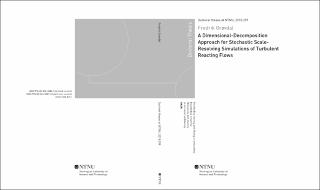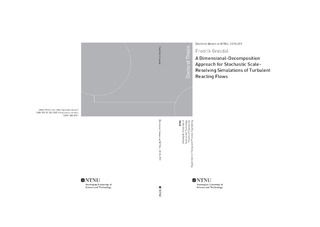| dc.description.abstract | High-fidelity and reliable numerical design tools are main keys to the development of novel gas turbines for hydrogen-rich fuels. However, state-of-the-art simulation tools for the most part only give a bulk approximation to the fluid flow and combustion processes. Direct Numerical Simulation (DNS) is a method that can provide detailed information about flow structures and turbulence-chemistry interactions but is computationally unaffordable for any large-scale applications. Numerical design tools that provide the capability of detailed predictive modeling of mixing and reaction at the needed scale and at a low computational cost are therefore highly in demand.
A unique new methodology for modeling and simulation of turbulent reactive flows is developed, relying on the dimensional-decomposition approach, decomposing 3D into 3x1D, and is further motivated, discussed and investigated. The model is developed on the basis of a 3D formulation of the Linear Eddy Model(LEM), thereby its name LEM3D. It involves three fully resolved orthogonally intersecting 1D LEM domains and their re-coupling, intended to capture 3D flow properties. As in the LEM framework, advection is treated in a Lagrangian manner with displacements of fluid cells, tree-dimensional advective turbulent stirring by one-dimensional stochastic rearrangements, and molecular mixing and chemical reactions are solved directly. LEM3D is currently implemented as a postprocessing tool for an initial RANS simulation or experimental data. In this hybrid approach, LEM3D complements RANS/experiments with unsteadiness and small-scale resolution in a computationally efficient manner, regarding its fully resolved resolution. In the present modeling approach, mean-flow information from RANS/experiment provides model input to LEM3D, which returns the scalar statistics needed for more accurate mixing and reaction calculations.
Three different iteration procedures, a breadth-first search, a checker-board algorithm and a naive approach, as well as parameters of the model framework are examined and tested for sensitivity towards the result. It is found that LEM3D is able to show additional details compared to the RANS simulation with low computational cost, in comparison to traditional DNS or LES simulations. A drawback for the additional detail is that the results deviate from the average-profiles prescribed. The artifacts of the models, strongly linked to the dimensional-decomposition approach and the need for re-coupling are thoroughly investigated.
To demonstrate the RANS-LEM3D model, the hybrid model is applied to various configurations with equal variation in success. A thorough investigation based on a flame front in a freely propagating laminar premixed flame for the approach is conducted, concluding that the flame stabilizes at the upstream face of the initial solution when both the advectional and auxiliary re-couplings are activated.
Capabilities of the model is demonstrated through simulations of both a lifted and attached turbulent N2-diluted hydrogen jet flame in a vitiated co-flow of hot products from lean H2/air combustion. The dependence of lift-off heights and flame structure on iteration schemes and model parameters are investigated in detail, along with other characteristics not available from RANS alone, such as the instantaneous and detailed species profiles and small scale mixing. Furthermore, results from LEM3D simulations of a vitiated co-flow burner are thoroughly examined adding a detailed discussion of the model artifacts.
The potential benefit of the hybrid model, once validated, compared to a corresponding DNS, is the huge cost saving factor of solving the reactive-diffusive equations on 1D domains, rather than in a full 3D computation. To leading order, the computational cost saving is estimated to be ~ 104 for the application to the lifted turbulent N2-diluted jet flame. The present work has demonstrated that LEM3D, as a post-processing tool to RANS within the hybrid RANS-LEM3D framework, complements RANS with unsteadiness, detailed information on the flame structure, small-scale mixing of reactive flows and fine-scale resolution of scalar concentration profiles. Finally, the main finding of the present work is that the auxiliary coupling introduces an unacceptable amount of artificial diffusion. A suggestion for future work is given based on the Péclet number.
Extensions to the model framework, with respect to the the previous work by Sannan et al. [87, 88] and Weydahl et al. [108, 109], includes implementation of finite rate chemistry, parallel computing, re-gridding, mass-fluxes, wafer-tracking, breadth-first iteration scheme, minimization of deviations by least squares and post-processing tools. | nb_NO |
| dc.relation.haspart | Paper 3:
Grøvdal, Fredrik; Sannan, Sigurd; Meraner, Christoph; Li, Tian; Løvås, Terese.
Dimensional Decomposition of Turbulent Reacting Flows.
The final published version is available in
Flow Turbulence and Combustion 2020
https://doi.org/10.1007/s10494-020-00191-5
Attribution 4.0 International (CC BY 4.0) | |

